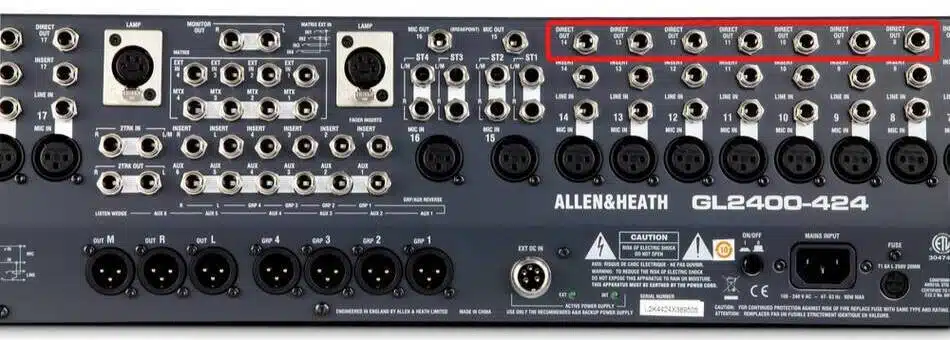Audio devices like amplifiers, mixer boards, etc., come with several outputs. A line out and a direct out are just two of these numerous output ports. Between these two output ports, line-outs are the most popular.
If you’ve been around instrumentalists and musicians, then you might have heard the term line out being used. What about the lesser-known direct out port? What do you know about this output port? Is it the same as a line out? All these questions and more will be addressed in this article, so read along.
Table of Contents
What Is Line Out?

A Line-out is an audio output port that transmits line-level audio signals from audio equipment to another. This port can be found on musical instruments like keyboards, bass, lead guitar, etc.
It can also be found on musical interfaces and equipment like amplifiers, mixers, synths, preamps, and many more. A line out is actually one of the most common audio outputs in the audio industry.
This is because most devices come with a line out. Thus, output devices like headphones and external speakers can be connected to your audio device using a line out.
A line out transmits a signal that is referred to as a line-level signal. A line-level signal is strong enough to be sent from one audio device to another However, to be able to hear it, it has to be amplified.
I have written extensively on line-outs, and I can’t cover everything in this article. Feel free to check out my article on Line Out vs Monitor Out, where I covered, in detail, what a line out is. Let’s continue.
What Is Direct Out?

A direct out is an audio port that receives its audio signal directly after the preamp stage. So, in essence, you can refer to direct out as preamp output or pre-out. Because a direct out signal is taken after the preamplifier stage, it is not affected by effects.
This enables direct-out ports to transmit a clean audio signal to your recording desk, monitor mixer, or amplifier. Therefore, it provides you with the cleanest signal path that is independent of EQ, fader level, and every other effect.
A direct-out port is not very common, and it’s not found on every audio device. However, some mixing consoles, guitar pedals, combos, and other audio equipment may have a direct out port.
If you own a small mixer, likely, it may not have a direct out port. On mixers with direct out ports, the direct output signals are taken before the signal goes through any signal processing.
This means that the audio signals from the direct out port are not processed through compression, EQ, and other effects from the mixer board.
Just as mentioned earlier, a direct out port can be found on some guitar pedals as well. Connecting your guitar pedal to a particular amp using the direct out is a way of bypassing the pedal.
This means that no matter the guitar effect added to the guitar’s signal path, the amp hooked to the direct out will receive a clean guitar signal. This makes a direct out ideal for musical setups involving more than one amp.
Others use the direct out as a way of recording the clean guitar signal with an audio interface so that they can use it for reamp purposes in the future.
Therefore, a direct out on a mixing console is ideal for running a live show while preserving clean recordings of every input signal for later mixing.
Is Direct Out the Same As Line Out?
The answer to this question is not as direct as it may seem. Functionally, a direct out and a line out can be the same. This is because they serve the same purpose. Both outputs can be used to run power amplifiers and for recording purposes as well.
However, their circuits are not identical. A line out’s circuit is built to pass through the signal processing chain of any device it is found on. That is why line-outs are affected by EQ, compression, effects, and other forms of audio signal processing.
On the other hand, direct-out circuits are not built to pass through the signal processing chain of devices they are found on. The circuit of a direct out terminates right after the preamplifier stage.
It is not processed through EQ, compression, gate, or any other effect on the device that will alter the signal.
Therefore, functionally, a line out and a direction out are the same. They perform the same function by transmitting line-level audio signals. However, the way their electronics have been engineered to work sets them apart.
Similarities Between Line Out and Direct Out
A line out and a direct out are similar. Therefore, it is not surprising that most people naturally assume that they are synonymous and that different audio brands choose which term to use in labeling their devices.
The main similarity between the two is that audio signals from both line-outs and direct-outs are line-level signals. Line level signals are low-level signals. These signals from both outputs are weak and cannot drive a speaker on their own.
Thus, both outputs transmit audio signals that need to be further amplified by an external amplifier.
Because line outs and direct outs both transmit low-level signals, the amount of impedance they generate is the same. This impedance is usually around 100 ohms and above, which makes them capable of driving loads with high input impedance.
Also, depending on the audio device, a line-out port can be made out of either a 1/4 inch port or an XLR port. Just like line-out ports, direct-out ports can be either 1/4 inch ports or XLR.
Difference Between Line Out and Direct Out
Even though technically, line-outs and direct-outs perform the same function, there are a few things that set them apart. Let’s take a look at these differences.
Line Out signal is processed; Direct Out signal is not.
As you may already know, an audio signal that is processed through audio effects and devices goes through some alteration. And the final output sounds different from the original.
Effects like reverb, delay, etc., as well as compression and equalization, add color to an audio signal.
A line out is affected by these front panel settings like EQ and other effects. This means when you plug the Line out of a musical instrument into a mixer’s input, you can apply compression or EQ to the signal. You can apply any signal processing to a line-out signal.
A line will transmit this alteration or addition to the audio signal out port.
However, direct out cannot be colored by EQ and effects. It is not affected by effects, compressions, and other alterations that are added to audio signals. This is because a direct-out signal is outputted directly after the preamp stage.
It does not pass through the equalization circuitry. Thus, any alteration done on your mixer or guitar pedal will not be passed on by a direct out port. Therefore, direct output signals are uncolored and dry.
Voltage Level
The voltage level of a line out differs from that of a direct out. A line out outputs voltages within the ranges of 0.750 to 1.4 volts. The voltage level of a line out is sufficient enough to drive most power amplifiers. This voltage level outputted by a line-out is higher than that of a direct out.
The voltage level of a direct out is around 0.002 to 0.07 volts. This voltage falls within the voltage range of microphone level signals. Thus, a direct out is suitable for the microphone inputs on a mixer board. It is not capable of driving most power amplifiers.
Therefore, though line outs and direct outs transmit low-level signals, the voltage level of line-out signals is slightly higher than that of direct outs.
Can A Direct Out Be Used As a Line Out?
Direct out can be used as a line out. This is because, just like line-outs, direct-outs also transmit line-level audio signals. Therefore, a direct out can transmit an audio signal to your recording desk, amplifier, or other audio devices.
Line-outs have been widely accepted as the universal standard port for transferring audio signals to drive amplifiers and record. That is why most audio devices come with line-out ports.
That notwithstanding, in situations where all your line-out ports are in use, you can use the direct-out port of your audio device as a line-out.
Conclusion
Line out and direct out ports are audio output ports that transmit low-level audio signals. They both enable you to send an audio signal to external amplifiers, mixing boards, etc.
However, a direct out receives its output signal directly after the preamplification stage. Due to this, it is not affected by EQ, compression, and other forms of signal processing. Audio signals from line-out ports are not terminated after the preamp stage. Thus, line-out signals are affected by equalization.

Hello, I’m Elijah. A writer on Geek Musician, based in Ghana-West Africa. I am a writer with a passion for research and reading. I usually spend my free time playing chess or watching movies. For more info, check out my about me page. Or read more of my articles here.
